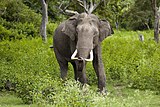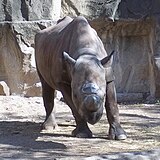What Is The Largest Land Animal In Africa
The heaviest country mammal is the African bush-league elephant, which has a weight of upward to x.ane tonnes (eleven.1 short tons). It measures ten–13 ft at the shoulder and consumes around 230 kilograms (500 lb) of vegetation a day. Its tusks have been known to reach two.7 m (9 ft) in length, although in modern populations they are most commonly recorded at a length of 0.vi–0.ix metres (2.0–three.0 ft).[one] The boilerplate walking speed of an elephant is vii.2 km/h (4.v mph), but they can run at recorded speeds of upwards to 24 km/h (fifteen mph).[2]
Heaviest extant country mammals [edit]
| Rank | Name | Image | Family | Taxonomy Classification | Mass[Notation ane] |
|---|---|---|---|---|---|
| one | African bush-league elephant |  | Elephantidae | Loxodonta africana | five,200–eight,000 kg (xi,500–17,600 lb)[three] |
| 2 | Asian elephant |  | Elephantidae | Elephas maximus: E. m. indicus, Eastward. thou. maximus, Due east. m. sumatranus, Eastward. chiliad. borneensis | 2,400–5,000 kg (five,300–xi,000 lb)[3] |
| three | African forest elephant |  | Elephantidae | Loxodonta cyclotis | 1,700–4,000 kg (3,700–8,800 lb)[4] |
| 4 | White rhinoceros |  | Rhinocerotidae | Ceratotherium simum: Ceratotherium simum cottoni, C. s. simum | three,000–three,600 kg (6,600–7,900 lb)[five] |
| 5 | Indian rhinoceros |  | Rhinocerotidae | Rhino unicornis | 2,070–3,000 kg (4,560–half-dozen,610 lb)[6] |
| 6 | Hippopotamus |  | Hippopotamidae | Hippopotamus amphibius: H. a. amphibius, H. a. kiboko, H. a. capensis, H. a. tschadensis, H. a. constrictus | 1,210–three,000 kg (two,670–half-dozen,610 lb)[vii] |
| 7 | Blackness rhinoceros |  | Rhinocerotidae | Diceros bicornis: D. b. small, D. b. michaeli, D. b. longipes | 850–2,896 kg (1,874–half dozen,385 lb)[8] |
| eight | Javan rhinoceros |  | Rhinocerotidae | Rhino sondaicus | 900–two,300 kg (2,000–5,100 lb)[ix] |
| ix | Gaur |  | Bovidae | Bos gaurus: B. thou. gaurus, B. g. readei, B. thou. hubbacki | 440–1,500 kg (970–3,310 lb)[10] |
| ten | Giraffe |  | Giraffidae | Giraffa camelopardalis: One thousand. c. camelopardalis, G. c. reticulata, G. c. angolensis, 1000. c. antiquorum, Thousand. c. tippelskirchi, One thousand. c. rothschildi, M. c. giraffa, G. c. thornicrofti, G. c. peralta | 700–i,400 kg (i,500–iii,100 lb)[xi] |
| 11 | Wild water buffalo |  | Bovidae | Bubalus arnee [Notation 2] | 600–1,200 kg (1,300–ii,600 lb)[thirteen] [12] |
| 12 | Bison |  | Bovidae | Bison bison: B. b. athabascae, B. b. bison | 540–one,400 kg (one,190–3,090 lb)[14] |
| 13 | Wild yak |  | Bovidae | Bos mutus | 500–1,200 kg (1,100–2,600 lb)[15] |
| 14 | Sumatran rhinoceros |  | Rhinocerotidae | Dicerorhinus sumatrensis | 500–1,000 kg (1,100–2,200 lb)[16] |
| 15 | Gayal |  | Bovidae | Bos frontalis | 650–1,000 kg (1,430–2,200 lb)[17] |
| xvi | Kouprey | Bovidae | Bos sauveli | 680–910 kg (1,500–2,010 lb)[xviii] [19] | |
| 17 | Banteng |  | Bovidae | Bos javanicus: B. j. javanicus, B. j. lowi, B. j. birmanicus | 590–900 kg (i,300–i,980 lb)[20] |
| 18 | Yak |  | Bovidae | Bos grunniens | 300–1,000 kg (660–2,200 lb)[21] |
| 19 | Giant eland |  | Bovidae | Taurotragus derbianus: T. d. derbianus, T. d. gigas | 400–ane,200 kg (880–ii,650 lb)[22] |
| 20 | African buffalo |  | Bovidae | Syncerus caffer: S. c. caffer, S. c. nanus, S. c. brachyceros, Southward. c. mathewsi, Due south. c. aequinoctialis | 300–870 kg (660–1,920 lb)[23] [24] |
| 21 | Eland |  | Bovidae | Taurotragus oryx: T. o. livingstonii, T. o. oryx, T. o. pattersonianus | 400–one,000 kg (880–2,200 lb)[25] [26] |
| 22 | Wisent |  | Bovidae | Bison bonasus | 500–1,000 kg (1,100–two,200 lb)[27] [xix] |
| 23 | Bactrian camel |  | Camelidae | Camelus bactrianus, Camelus ferus | 300–1,000 kg (660–ii,200 lb)[28] [29] |
| 24 | Water buffalo |  | Bovidae | Bubalus bubalis | 300–1,100 kg (660–ii,430 lb)[ citation needed ] |
| 25 | Dromedary |  | Camelidae | Camelus dromedarius | 400–ane,000 kg (880–2,200 lb)[30] |
| 26 | Cattle |  | Bovidae | Bos taurus, Bos indicus, Bos primigenius | 200–ane,700 kg (440–3,750 lb)[31] [32] |
| 27 | Moose |  | Cervidae | Alces alces: A. a. alces, A. a. pfizenmayeri, A. a. cameloides, A. a. buturlini, A. a. americana, A. a. andersoni, A. a. gigas, A. a. shirasi | 200–820 kg (440–1,810 lb)[33] [34] [35] |
| 28 | Polar bear |  | Ursidae | Ursus maritimus | 300–ane,000 kg (660–2,200 lb)[36] [37] [38] |
| 29 | Chocolate-brown bear |  | Ursidae | Ursus arctos: U. a. arctos, U. a. collaris, U. a. beringianus, U. a. isabellinus, U. a. gobiensis, U. a. lasiotus, Ursus arctos marsicanus, U. a. syriacus, U. a. pruinosus, U. a. horribilis, U. a. gyas,U. a. middendorffi, U. a. sitkensis, U. a. stikeenensis, U. a. nelsoni, U. a. crowtheri | 150–ane,000 kg (330–2,200 lb)[39] [forty] [41] [42] |
| 30 | Elk |  | Cervidae | Cervus canadensis: C. c. alashanicus, C. c. kansuensis, C. c. macneilli, C. c. manitobensis, C. c. nannodes, C. c. nelsoni, C. c. roosevelti, C. c. xanthopygus, C. c. sibiricus, C. c. songaricus, C. c. wallichii | 170–600 kg (370–i,320 lb)[43] [44] |
Notes [edit]
- ^ Entries are ordered by the median or mean body mass (in that guild of preference), if available, or otherwise past the geometric mean of the body mass range limits.
- ^ The domestic h2o buffalo (Bubalus bubalis) likewise occurs as feral populations, sometimes in sympatry with Bubalus arnee.[12]
References [edit]
- ^ Larramendi, A. (2016). "Shoulder height, body mass and shape of proboscideans" (PDF). Acta Palaeontologica Polonica. 61 (3): 537–574. doi:10.4202/app.00136.2014. S2CID 2092950.
- ^ Stanford News Service Stanford News Service Retrieved April 3, 2016
- ^ a b Larramendi, A. (2015). "Proboscideans: Shoulder Peak, Body Mass and Shape" (PDF). Acta Palaeontologica Polonica. doi:10.4202/app.00136.2014. S2CID 2092950. Retrieved 23 May 2020. This is the range for 90% of the male population; run into Table eight.
- ^ Morgan, B. J.; Lee, P. C. (2003). "Forest elephant (Loxodonta africana cyclotis) stature in the Reserve de Faune du Petit Loango, Gabon". Journal of Zoology. 259 (iv): 337–344. doi:x.1017/s0952836902003291.
- ^ Groves, C.P. (1972). "Ceratotherium simum". Mammalian Species (8): 1–6. doi:10.2307/3503966. JSTOR 3503966. Run into page 1.
- ^ Laurie, West.A.; Lang, Eastward.M.; Groves, C.P. (1983). "Rhinoceros unicornis". Mammalian Species (211): one–6. doi:ten.2307/3504002. JSTOR 3504002. Weights are for captive males; encounter folio one.
- ^ Weston, E.G.; Lister, A.K. (2009). "Insular dwarfism in hippos and a model for brain size reduction in Homo floresiensis". Nature. 459 (7243): 85–88. Bibcode:2009Natur.459...85W. doi:10.1038/nature07922. PMC2679980. PMID 19424156. Adult range (males plus females; see Supplementary Give-and-take on page 15 of Supplementary Material); annotation mean mass = 1,495 kg.
- ^ Hillman-Smith, A.K.K..; Groves, C.P. (1994). "Diceros bicornis". Mammalian Species (455): ane–viii. doi:10.2307/3504292. JSTOR 3504292. See page ii.
- ^ Dinerstein, East. (2003). The Return of the Unicorns; The Natural History and Conservation of the Greater Ane-Horned Rhino. New York City: Columbia Academy Press. ISBN978-0-231-08450-5.
- ^ MacKinnon, J. (2008). "Gaur". In Smith, A. T.; Xie, Y. (eds.). A Guide to the Mammals of China. Princeton: Princeton University Press. p. 472. ISBN9781400834112.
- ^ Hall-Martin, A.J. (1977). "Giraffe Weight Interpretation Using Dissected Leg Weight and Body Measurements". The Journal of Wild animals Management. 41 (4): 740–745. doi:10.2307/3799999. JSTOR 3799999. Male weight range, from Table 1.
- ^ a b Aryal, A.; Shrestha, T.M.; Ram, A.; Frey, Westward.; Groves, C.; Hemmer, H.; Dhakal, M.; Koirala, R.J.; Heinen, J.; Raubenheimer, D. (2011). "Phone call to conserve the Wild H2o Buffalo (Bubalus arnee) in Nepal" (PDF). International Periodical of Conservation Scientific discipline. 2 (4): 261–268. Retrieved 2020-05-25 . See folio 262.
- ^ Ahrestani, F.S.; Heitkönig, I.M.A.; Matsubayashi, H.; Prins, H.H.T. (2016). "Grazing and Browsing by Large Herbivores in South and Southeast Asia" (PDF). In Ahrestani, F.S.; Sankaran, M. (eds.). The Ecology of Large Herbivores in South and Southeast Asia. Ecological Studies : Analysis and Synthesis. Ecological Studies. Vol. 225. Springer Netherlands. pp. 99–120. doi:x.1007/978-94-017-7570-0_4. ISBN978-94-017-7568-7. ISSN 0070-8356. Retrieved 2020-05-25 . See page 104.
- ^ Meagher, M. (1986). "Bison bison". Mammalian Species (266): ane–8. doi:x.1093/mspecies/266.i. JSTOR 3504019. Male weight range, folio 1.
- ^ Han Jianlin, M. Melletti, J. Burton, 2014, Wild yak (Bos mutus Przewalski, 1883), Ecology, Evolution and Behavior of Wild Cattle: Implications for Conservation, Chapter 1, p.203, Cambridge Academy Press
- ^ Groves, C. P.; Kurt, F. (1972). "Dicerorhinus sumatrenis" (PDF). Mammalian Species. 21 (21): 1–6. doi:10.2307/3503818. JSTOR 3503818. Archived from the original (PDF) on 1 November 2012.
- ^ Gayal - Facts, Diet, Habitat & Pictures on Animalia.bio
- ^ [ane] Archived 2011-08-10 at the Wayback Motorcar (2011).
- ^ a b Burnie D and Wilson DE (Eds.), Animal: The Definitive Visual Guide to the World's Wildlife. DK Developed (2005), ISBN 0789477645
- ^ A. Hoogerwer, 1970, Udjung Kulon: The State of the Last Javan Rhino, Physical Details pp 167-171, Brill Archive
- ^ Buchholtz, C. (1990). True Cattle (Genus Bos). pp. 386–397 in Due south. Parker, ed. Grzimek'southward Encyclopedia of Mammals, Book 5. New York: McGraw-Hill Publishing Company. (quoted in Oliphant, 1000. (2003). Bos grunniens (On-line), Animal Diversity Web. Accessed 4 Apr 2009)
- ^ Atlan, B. "Taurotragus derbianus". Academy of Michigan Museum of Zoology. Animal Variety Web. Retrieved 29 July 2012.
- ^ Pienaar, U. de V. (1969). "Observation on developmental biology, growth and some aspects of the population ecology of the African Buffalo (Syncerus caffer caffer Sparrman) in the Kruger National Park". Koedoe. 12 (i). doi:10.4102/koedoe.v12i1.745. ISSN 2071-0771. Combined adult male range for Kruger National Park, Southward Africa (639.6-767.5 kg; Table 1, folio ~56) and E Africa (678.half dozen-835.ane kg; page 36)
- ^ Cape Buffalo, Encyclopedia Britannica https://www.britannica.com/brute/Greatcoat-buffalo
- ^ Kingdon, J (1997). The Kingdon Field Guide to African Mammals. Princeton University Press. ISBN978-0-691-11692-1.
- ^ "Animal Bytes – Common Eland". Seaworld.org. Archived from the original on 2012-06-xix. Retrieved 2012-04-08 .
- ^ Boitani, Luigi, Simon & Schuster's Guide to Mammals. Simon & Schuster/Touchstone Books (1984), ISBN 978-0-671-42805-ane
- ^ "Bactrian Camel". EdgeofExistence.org. EDGE. 2010.
- ^ "Bactrian Camel". UltimateUngulate.com.
- ^ "Dromedary, Arabian camel". ultimateungulate.com.
- ^ Friend, John B., Cattle of the World, Blandford Printing, Dorset, 1978
- ^ "Hereford cattle weight". Archived from the original on 24 January 2015.
- ^ "Moose". Env.gov.nl.ca. Archived from the original on Jan 2, 2008. Retrieved Nov 27, 2009.
- ^ Franzmann, A. W. (1981). Alces alces. Mammalian Species, 1-seven.
- ^ Wood, The Guinness Book of Fauna Facts and Feats. Sterling Pub Co Inc. (1983), ISBN 978-0-85112-235-nine
- ^ Derocher, A. E.; Wiig, Ø. (2002). "Postnatal growth in body length and mass of polar bears (Ursus maritimus) at Svalbard". Journal of Zoology. 256 (3): 343–349. doi:10.1017/S0952836902000377.
- ^ Hemstock, p. 4
- ^ Woods, G.L. (1983). The Guinness Book of Creature Records. Enfield, Middlesex : Guinness Superlatives. p. 240. ISBN978-0-85112-235-nine.
- ^ Christiansen, P. (1999). "What size were Arctodus simus and Ursus spelaeus (Carnivora: Ursidae)?". Annales Zoologici Fennici. 36 (ii): 93–102. JSTOR 23735739.
- ^ Feldhamer, 1000. A.; Thompson, B. C.; Chapman, J. A. (2003). Wild mammals of North America: biological science, management, and conservation. JHU Press. ISBN9780801874161.
- ^ Forest, Gerald (1983). The Guinness Book of Creature Facts and Feats. ISBN978-0-85112-235-9.
- ^ LaFee, Scott (2008-05-29). "Seeds of doubt". The San Diego Union-Tribune . Retrieved 2016-03-08 .
- ^ "Cervus elaphus". Animal Diversity Web. University of Michigan, Museum of Zoology. Archived from the original on 10 November 2014. Retrieved 4 December 2010.
- ^ Eide, Sterling. "Roosevelt Elk". Alaska Department of Fish and Game. Archived from the original on 5 June 2007. Retrieved 4 December 2010.
Source: https://en.wikipedia.org/wiki/List_of_heaviest_land_mammals
Posted by: bransonhisherecur.blogspot.com

0 Response to "What Is The Largest Land Animal In Africa"
Post a Comment